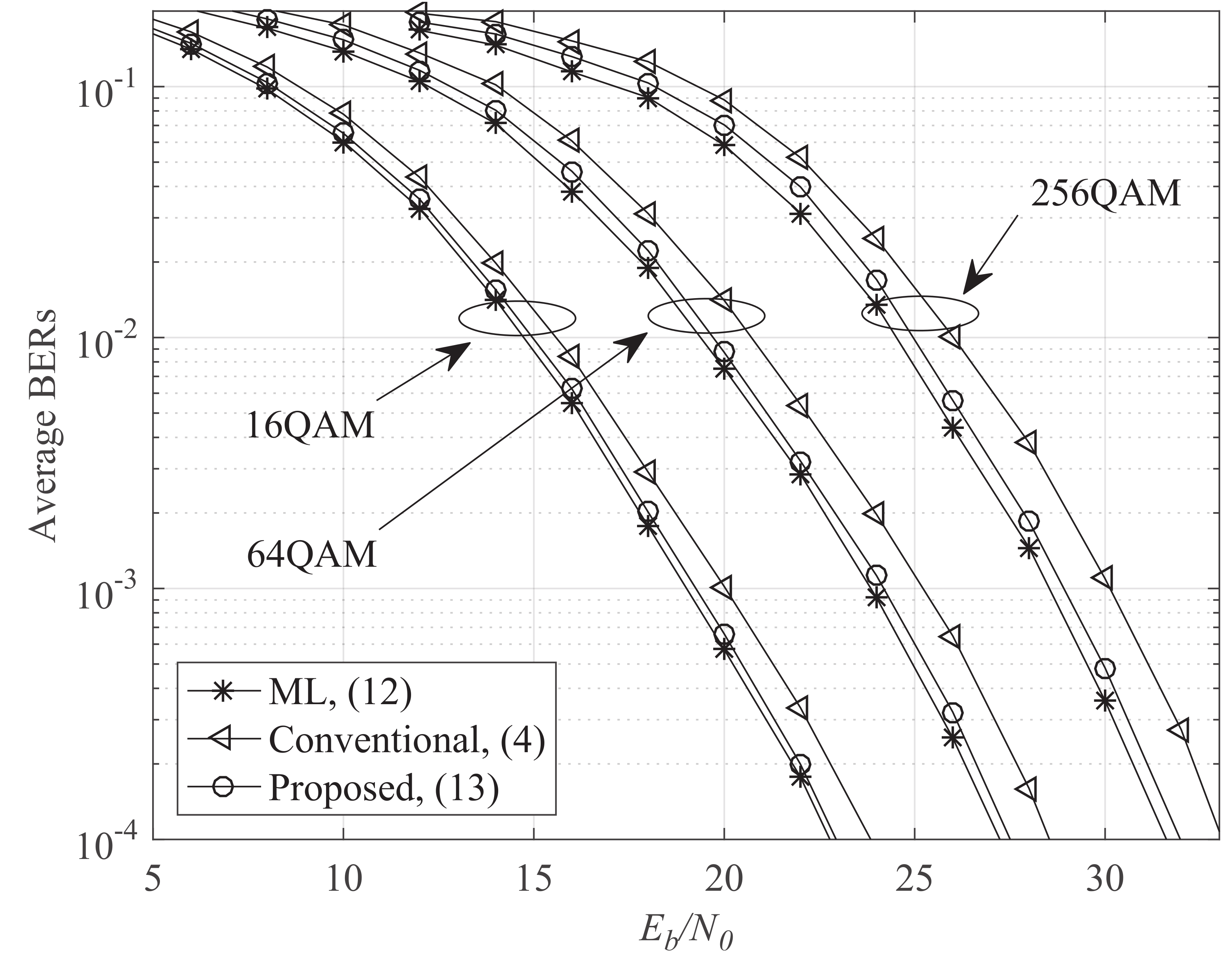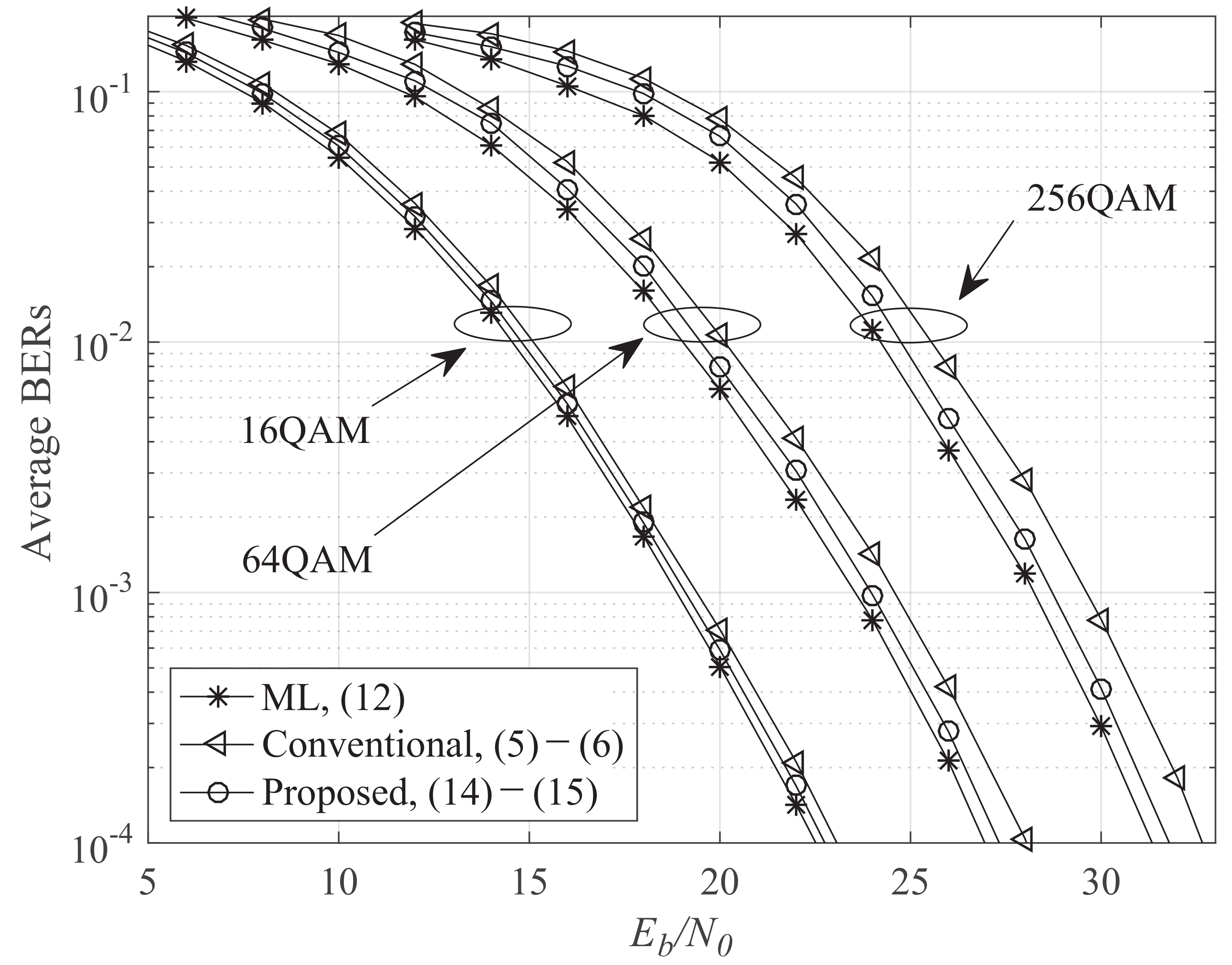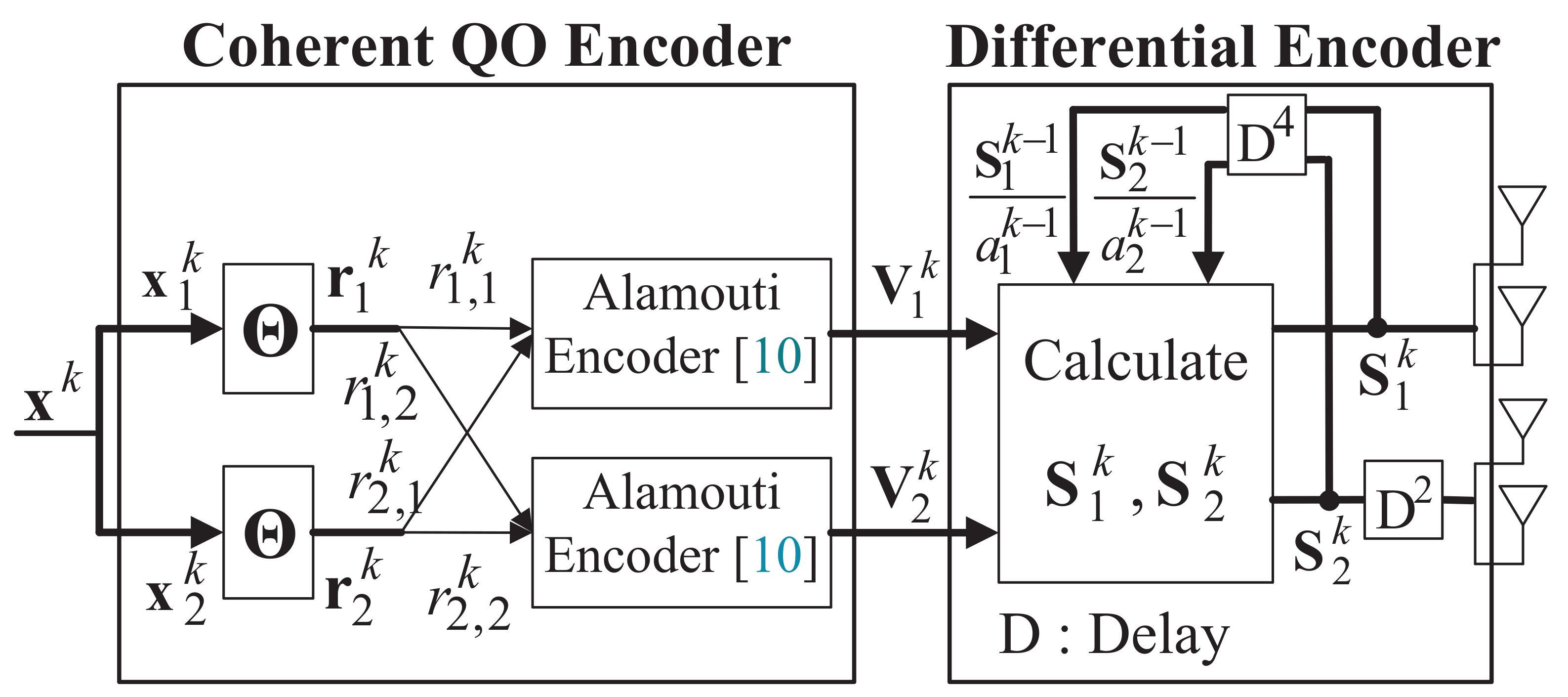1. Introduction
So-called quasi-orthogonal (QO) design, adopted in coherent space–time codes (STBCs) [
1,
2,
3], enjoys some preferable features of full spatial diversity gain as well as simplified maximum-likelihood (ML) detection based on complex or real pair-wise symbols for any type of signal constellation. These QO-STBCs have been developed to be applicable not only to 4G long-term evolution (LTE) [
4], but also to a 5G new radio (NR) communication system [
5,
6] that is currently commercializing beyond standardization.
However, for so-called differential space–time modulations (DSTMs) [
7,
8] based on the QO design, hereafter referred to as QO-DSTM, the efficient pair-wise ML detection applied in the conventional QO-STBCs is no longer available at a receiver when using general QAM. This is mainly since power-normalization with a constraint of fixed total transmit energy in a transmitter inevitably generates dependencies among all differentially modulated signals on each other. Hence, [
7,
8] presents alternative pair-wise, but not ML, detections showing degraded performance compared to the ML decoding. Furthermore, ref. [
9] does not exhibit significant performance loss unlike [
7,
8], but has a critical disadvantage due to its decoding complexity greatly increasing as the modulation order increases.
For this reason, in this paper, new complex and real pair-wise detections for the conventional QO-DSTMs [
7,
8] with four transmit antennas were proposed for general QAM without additional operation. A key feature in the proposed detections is that when decoding a given complex or real symbols pair, all the other pairs’ variant power values contained in an ML metric are simply replaced by or estimated to be their constant mean values. This mean-based estimation effectively cuts off the dependencies between the given differential symbols which pair with all the other pairs, thus enabling the independent joint detection of two complex or real symbols, such as the conventional ones [
7,
8], with the resulting performances much closer to ML decoding.
2. Conventional QO-DSTMs and Differential Pair-Wise Detections
The conventional QO-DSTMs [
7,
8] with four transmit antennas can be constructed by serially concatenating the coherent QO code with differential encoding, as shown in
Figure 1.
The transmitter of
Figure 1 first encodes a
kth input vector
of length 4 through the conventional coherent QO encoder [
2,
3] consisting of precoder
and Alamouti encoder [
10], resulting in:
where
with an unitary precoder
. Notice that the precoder
is chosen so that the precoded vector
has different values for any distinct
[
2,
3], and thus is mapped to
in a one-to-one relationship. Then, each
is differentially modulated with an iterative fashion as follows:
where
is a power-normalization factor to satisfy
with an
identity matrix
.
denotes a Hermitian operator. The differentially modulated
are finally transmitted through four transmit antennas in a time-multiplexed form as shown in
Figure 1, and finally arrive at a receiver through
independent and identical MIMO fading channels.
Assuming a receive vector
corresponding to
, Zhu’s QO-DSTM [
7] presents a near-ML complex pair-wise detection of
, where
for an optimal complex precoder
, given as
where
and
.
is a transpose operator and
.
Furthermore, in order to further reduce the decoding complexity of (
4), Chang’s QO-DSTM [
8] uses a real precoder
with
, producing real pair-wise detection of
and
,
, given as
In (
4)–(6),
and
denote real and imaginary parts, respectively.
3. New Pair-Wise Detections
Before deriving new pair-wise decoding, we first rearrange the exact ML decoding ([
3], Equation (33)) in a vector form as follows:
where
with
,
and
. The approximation of (8) uses an assumption of high SNR, i.e.,
[
7,
8]. Furthermore, the equality of (9) comes from no change of magnitude of any conjugated signal.
Here, let us define a
unitary matrix
with
to satisfy
. Then, by multiplying the left of (9) with
, the ML metric can be written as the summation of two equations, including each
as follows:
where diagonal matrix
,
with
and
. The equality of (
10) uses an energy conserving property of the unitary matrix
.
From (12), we can see that if all
in
are independent of
, each
can be separately decoded by minimizing
. Unfortunately, the values
in
are variant with respect to
or all the input QAM signals
, implying the unfeasibility of pair-wise ML detection at the receiver. Specifically, in order to decode
, we need to know the two exact values of
and
in
containing the other signals
. Conversely, for decoding
, the two values
and
corresponding to the other
need to be known. Considering that
are normalizing terms including
and
, we conclude that the dependency between two symbol pairs
and
indeed originates from the power-normalization with the constraint of total transmit power in (
3), thus implying that this dependency will be not avoidable for the general QAM.
Hence, in order to make separate detections of possible, it should be done to break up the dependency relationship between and in . For this goal, when decoding , we simply replace or estimate the values of the other by their mean values, i.e., , and also when decoding , . In this way, the decoding of can be performed only by using elements containing and the same can be done for decoding only by using elements.
Hence, this simple mean-based estimation produces a new complex pair-wise decoding of
, given as
where
with
.
Moreover, for a real
, the mean-based estimation can be applied to
in (
13) one more time for the separate decoding of
and
, i.e.,
when decoding
and also
when decoding
, resulting in:
where
with
and
with
.
Obviously, the new pair-wise detections of (
13)–(15) are not equal to the ML decoding of (12), but exhibit performances within only about 0.5 dB compared to the ML receiver for all simulation cases, which will be shown in the following simulation results.
Notice that with some manipulations, the conventional detection of (
4) can be shown to be equal to the new one of (
13) setting
to be
, i.e.,
, given as
where the equality of (
16) is from that
is absolutely irrelevant to the current input signals
or
. Following the same derivations, (
5) and (6) can also be proven to be equal to the new ones of (
14) and (15), respectively, setting
to be
. This means that the conventional detections can be seen as the ones to cut off the dependency between two
or four
from each other by estimating
to be simply
. Moreover, since the proposed methods are the same symbol by symbol decoding as the conventional methods except for the
computation, performance improvement can be expected without increasing the same decoding complexity.
Defining
,
Table 1 compares the accuracies of
s used in the conventional and new detections for the QO-DSTMs [
7,
8] with perfect knowledge of
.
From
Table 1, the estimation errors of
in the new detections are shown to be greatly lower than those of the convention detections. Furthermore, the gap between both detections becomes slightly larger as increasing the modulation order. This is obvious since the conventional detections do not consider the values of current QAM input signals
for estimating
unlike new ones, and thus the estimation error increases much more for a higher modulation order.
4. Simulation Results
All simulations are done based on an independent data frame consisting of 128 blocks. Each block has four QAM symbols. For propagation channel models, it is assumed that the four MIMO channel gains have independent and identical Rayleigh distributions, and also are constant during each frame with independent distribution. Furthermore, in all decodings, we use and calculated from previously detected symbols.
Figure 2 shows average bit error rates (BERs) of the new and conventional complex pair-wise detections for the Zhu’s QO-DSTM [
7] using
. For the comparison of performances, the ML results of (12) are also included. Firstly, the new pair-wise detection is shown to achieve more improved performance compared to the conventional one for all simulation cases. The performance gain is much larger especially as the modulation order increases. Specifically, for 16, 64 and 256 QAMs, the respective SNR gains at BER =
are about 0.8, 1.0, 1.2 dBs. This is mainly because the new detection is performed based on more accurately estimated
compared to the conventional one, especially for a higher modulation order, as shown in
Table 1. Furthermore, we note that the proposed detection shows an SNR loss of less than only 0.2 dB compared to the ML decoding for all cases.
Figure 3 shows the average BERs of the new and conventional real pair-wise detections for the Chang’s QO-DSTM [
8] using
. Here, the ML results are also included for comparing performances. First the performance trends in
Figure 3 are almost the same as those of
Figure 2 with the identical reasons as in
Table 1. Specifically, the respective SNR gains for 16, 64 and 256 QAMs at BER =
are about 0.3, 0.6, 0.9 dBs. Furthermore, the proposed detection shows an SNR loss of less than 0.5 dB compared to the ML decoding for all cases.
Comparing the simulation results in
Figure 2 and
Figure 3, we can see that the performance gain comparing to the conventional system is more significant when using the complex precoder in
Figure 2. This is mainly due to the difference in estimation errors between the proposed and conventional methods listed in
Table 1. Namely, when using the complex precoder, the gap of estimation errors for
between these two methods are larger than those when using the real precoder for all modulation cases, as shown in
Table 1.
5. Conclusions
In this paper, we proposed new complex and real pair-wise detections for the conventional QO-DSTMs with four transmit antennas for general QAM. The proposed detections exhibit a greatly improved performance compared to the conventional ones, especially, for a higher modulation order and also a performance almost identical with the ML decoding.
Hence, considering decoding the complexity and error performances, the new pair-wise detections are much more attractive for demodulating the QO-DSTMs. The mean-based estimation used in the proposed detections can indeed be applied to any other DSTMs based on amicable orthogonal [
11] or QO [
12] space-time codes with more than four transmit antennas and general QAM. In addition, it can be applicable for the other differential modulation systems in such as radio frequency technology [
13], underwater communications [
14], heterogeneous networks [
15] and wireless sensor networks [
16], which can also be applied to the artificial intelligence field [
17] which is in the spotlight these days.








